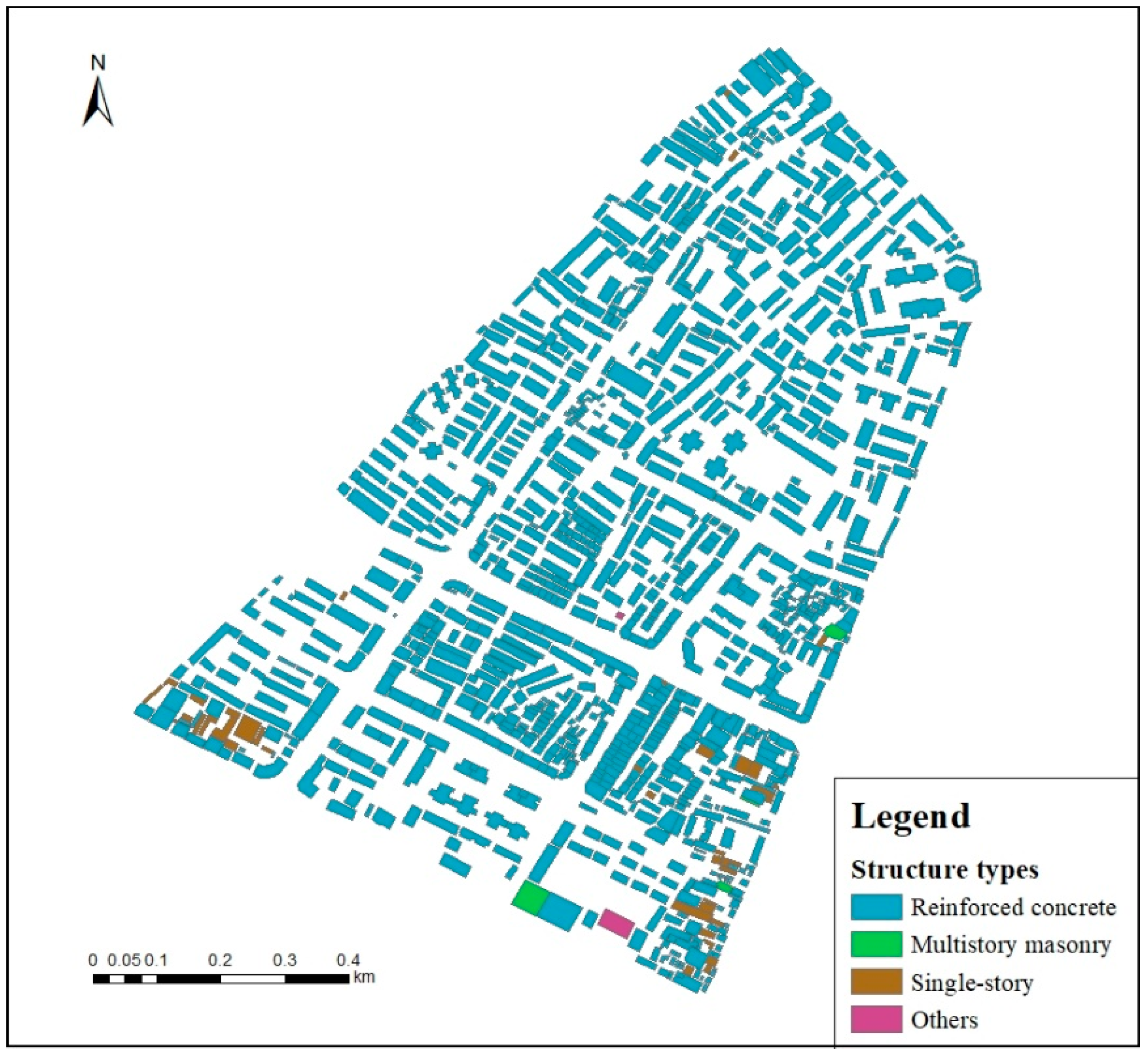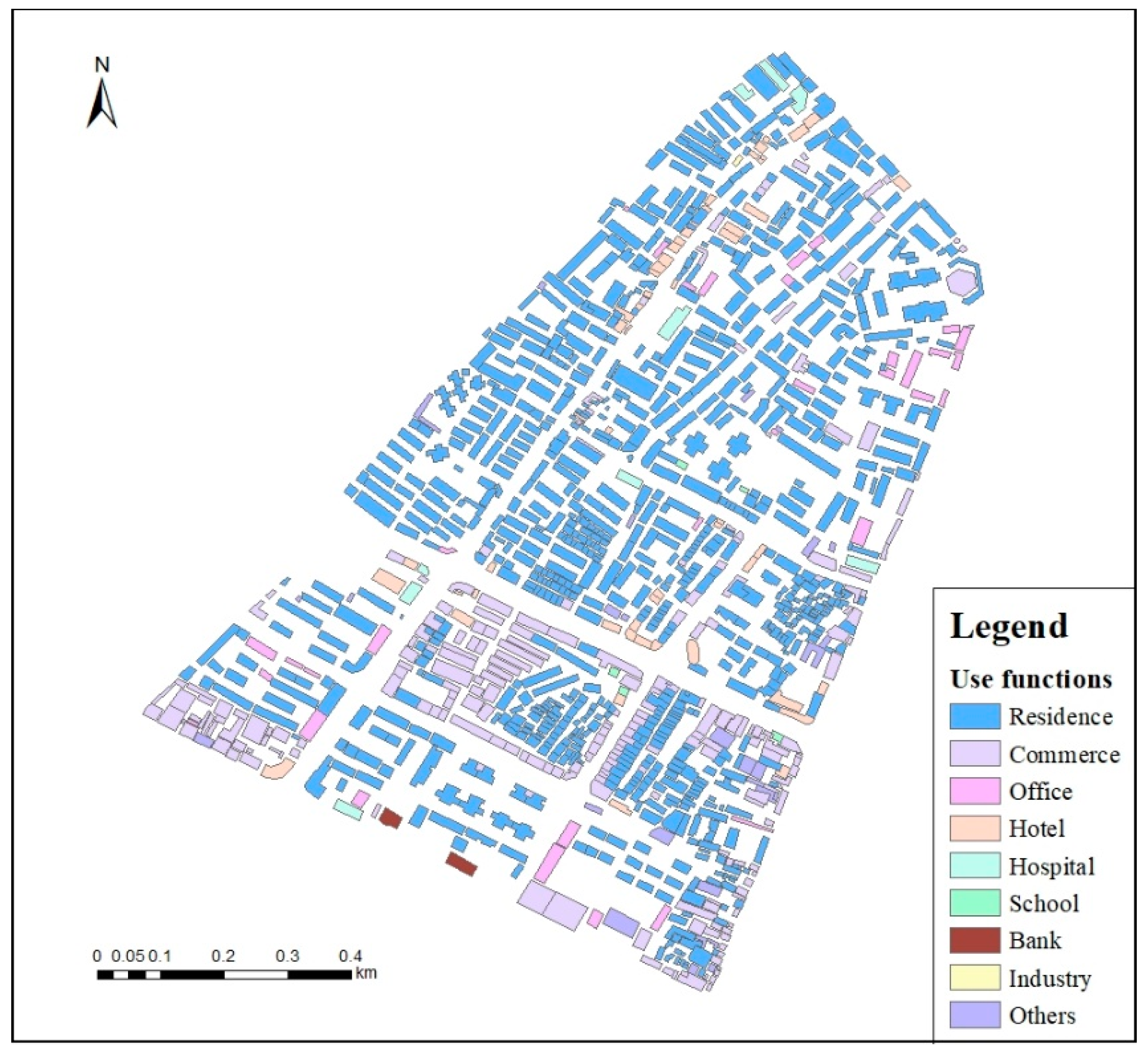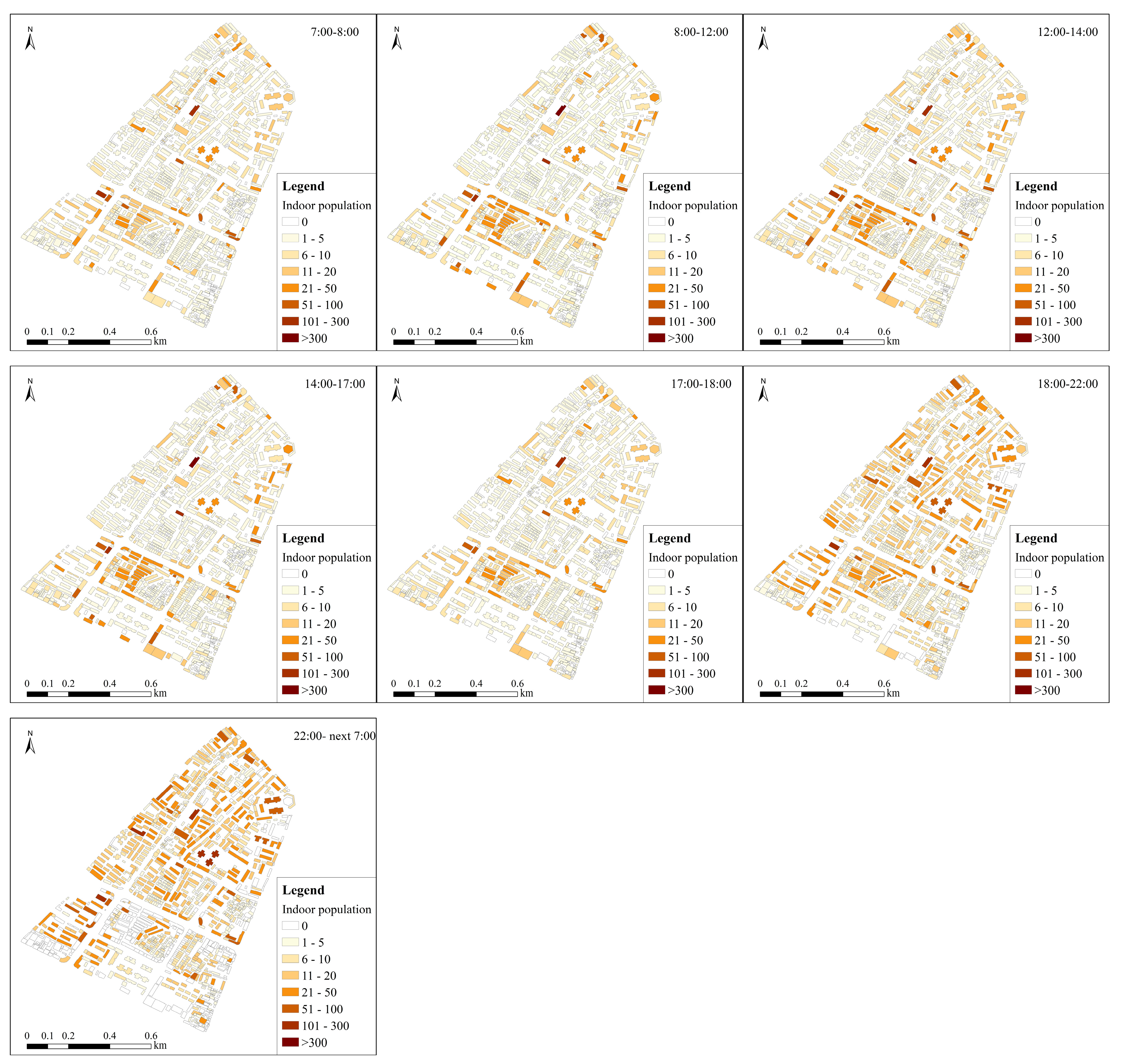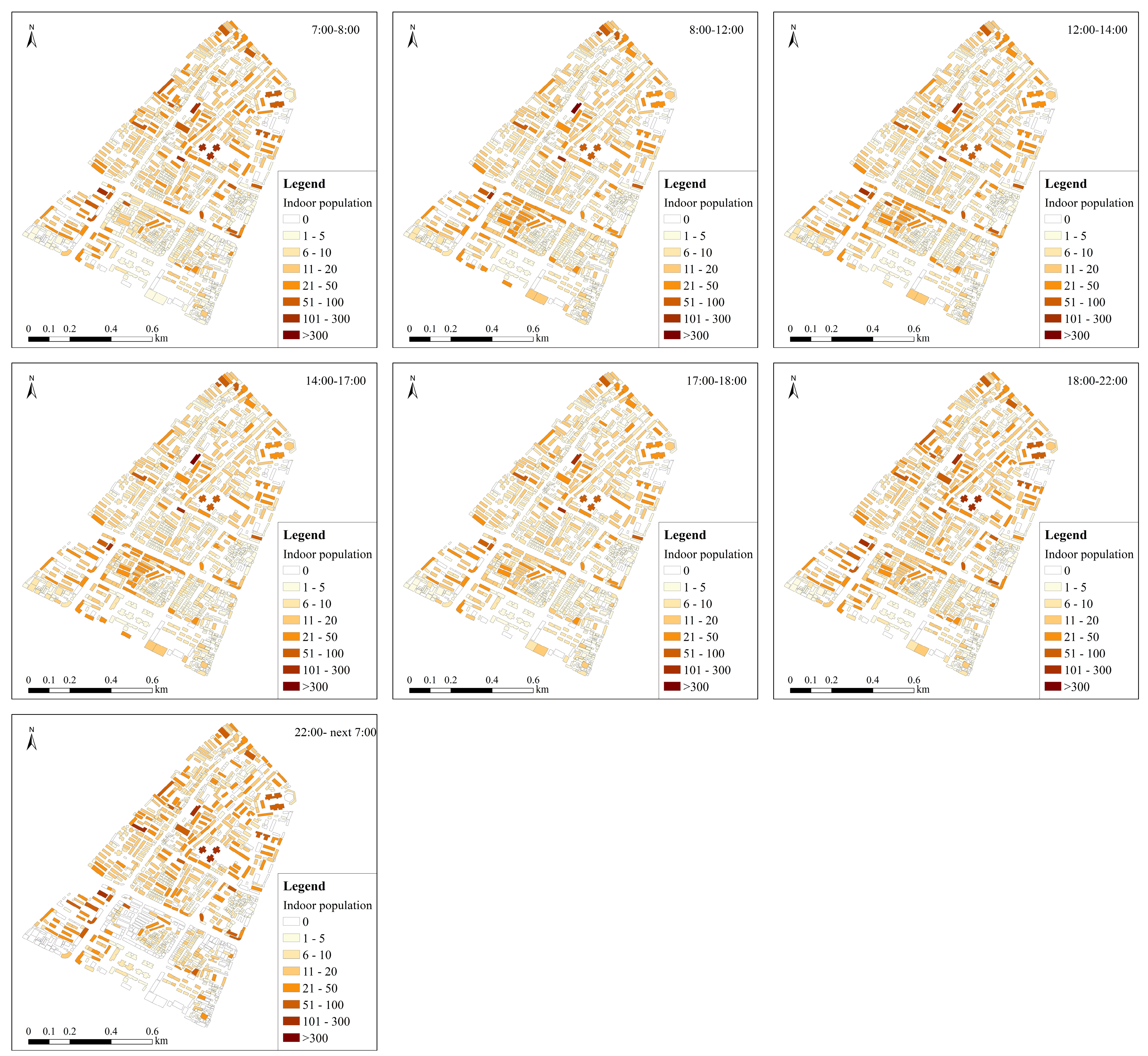Fine–Scale Spatiotemporal Distribution Assessment of Indoor Population Based on Single Buildings: A Case in Dongcheng Subdistrict, Xichang, China
Abstract
1. Introduction
2. Literature Review
2.1. Population Spatial Distribution
2.2. Temporal Changes in Population Distribution
3. Method and Data
3.1. Study Area
3.2. Method
3.2.1. Model to Assess Indoor Population Exposure in Single Buildings
3.2.2. Population Accommodation Density of Buildings
3.2.3. Determination of Occupancy Rates for Different Functional Buildings
3.3. Data and Procedures
3.3.1. Buildings Data
3.3.2. Population Data
4. Results
4.1. Spatial Distribution of Single Buildings
4.2. Population Distribution at Different Times of the Day
4.2.1. Population Accommodation Density of Various Buildings
4.2.2. Occupancy Rate Changes in Different Functional Buildings in a Day
4.2.3. Spatiotemporal Changes of Population Exposure in Different Functional Buildings
5. Discussion
5.1. Spatiotemporal Distribution Law of Indoor Population
5.2. Implications and Limitations
6. Conclusions
Author Contributions
Funding
Institutional Review Board Statement
Informed Consent Statement
Data Availability Statement
Conflicts of Interest
References
- UNDP. Reducing Disaster Risk: A Challenge for Development; UNDP Bureau for Crisis Prevention and Recovery: New York, NY, USA, 2004. [Google Scholar]
- Coburn, A.; Spence, R. Earthquake Protection, 2nd ed.; John Wiley & Sons: Chichester, UK, 2002. [Google Scholar]
- Işık, E.; Sağır, Ç.; Tozlu, Z.; Ustaoğlu, Ü.S. Determination of Urban Earthquake Risk for Kırşehir, Turkey. Earth Sci. Res. J. 2019, 23, 237–247. [Google Scholar] [CrossRef]
- UNISDR. Making Development Sustainable: The Future of Disaster Risk Management. Global Assessment Report on Disaster Risk Reduction; United Nations Office for Disaster Risk Reduction (UNISDR): Geneva, Switzerland, 2015. [Google Scholar]
- Freire, S. Modeling of Spatiotemporal Distribution of Urban Population at High Resolution—Value for Risk Assessment and Emergency Management. In Intelligent Systems for Crisis Management; Springer: Berlin/Heidelberg, Germany, 2010. [Google Scholar]
- Liang, Y.T.; Wen, J.H.; Du, S.Q.; Xu, H.; Yan, J.P. Spatial–temporal distribution modeling of population and its applications in disaster and risk management. J. Catastrophology 2015, 30, 220–228. [Google Scholar]
- FEMA (Federal Emergency Management Agency). Multihazard loss estimation methodology—Earthquake model. In HAZUS–MH MR4: Technical Manual; Department of Homeland Security: Washington, DC, USA, 2003. [Google Scholar]
- Sutton, P.; Elvidge, C.; Obremski, T. Building and evaluating models to estimate ambient population density. Photogramm. Eng. Remote Sens. 2003, 69, 545–553. [Google Scholar] [CrossRef]
- Chen, K.; Mc Aneney, J.; Blong, R.; Leigh, R.; Hunter, L. Magill CDefining area at risk and its effect in catastrophe loss estimation: A dasymetric mapping approach. Appl. Geogr. 2004, 24, 97–117. [Google Scholar] [CrossRef]
- NRC (National Research Council). Tools and Methods for Estimating Populations at Risk from Natural Disasters and Complex Humanitarian Crises; Report by the National Academy of Sciences; National Academy Press: Washington, DC, USA, 2007.
- Corner, R.J.; Ongee, E.T.; Dewan, A.M. Spatiotemporal Patterns of Population Distribution; Dewan, A., Corner, R., Eds.; Dhaka Megacity; Springer Geography; Springer: Dordrecht, The Netherlands, 2014. [Google Scholar]
- Wu, S.S.; Qiu, X.; Wang, L. Population estimation methods in GIS and remote sensing: A review. GIScience Remote Sens. 2005, 42, 80–96. [Google Scholar] [CrossRef]
- Azar, D.; Engstrom, R.; Graesser, J.; Comenetz, J. Generation of fine–scale population layers using multi–resolution satellite imagery and geospatial data. Remote Sens. Environ. 2013, 130, 219–232. [Google Scholar] [CrossRef]
- Pan, S.; Du, S.Q.; Xu, H.; Wu, Y.J.; Wang, L.M.; Zong, W.; Wen, J.H. Spatio–Temporal Analysis on Low Elevation Coastal Zone and Its Population in the Yangtze River Delta Region. Areal Res. Dev. 2016, 35, 161–165. [Google Scholar]
- Xu, J.H.; An, J.W.; Nie, G.Z. A quick earthquake disaster loss assessment method supported by dasymetric data for emergency response in China. Nat. Hazards Earth Syst. Sci. 2016, 16, 885–899. [Google Scholar] [CrossRef]
- Ding, W.X.; Li, X.L.; Li, Z.Q.; Dou, A.X.; Zhang, Y.M.; Temu, Q.L. Population and housing grid spatialization in Yunnan Province based on grid sampling and application of rapid earthquake loss assessment: The Jinggu Ms6.6 earthquake. Geod. Geodyn. Geod. Geodyn. 2014, 5, 25–33. [Google Scholar]
- Feng, T.T. Urban Small Area Population Estimation Based on High–Resolution Remote Sensing Data; Wuhan University: Wuhan, China, 2010. [Google Scholar]
- Bai, Z.Q.; Wang, J.L.; Yang, F. Research progress in spatialization of population data. Prog. Geogr. 2013, 32, 1692–1702. [Google Scholar]
- Freire, S.; Aubrecht, C. Integrating population dynamics into mapping human exposure to seismic hazard. Nat. Hazards Earth Syst. Sci. 2012, 12, 3533–3543. [Google Scholar] [CrossRef]
- Kang, C.G.; Liu, Y.; Ma, X.J.; Wu, L. Towards estimating urban population distributions from mobile call data. J. Urban Technol. 2012, 19, 3–21. [Google Scholar] [CrossRef]
- Ara, S. Impact of temporal population distribution on earthquake loss estimation: A case study on Sylhet, Bangladesh. Int. J. Disaster Risk Sci. 2014, 5, 296–312. [Google Scholar] [CrossRef]
- De Lotto, R.; Pietra, C.; Venco, E.M. Risk Analysis: A Focus on Urban Exposure Estimation. In Computational Science and Its Applications—ICCSA 2019; Mirsra, S., Gervasi, O., Murgante, B., Stankova, E.N., Korkhov, V., Torre, C.M., Rocha, A.M.A.C., Taniar, D., Apduhan, B.O., Tarantino, E., Eds.; Springer: Cham, Switzerland, 2019. [Google Scholar]
- Rivera, F.; Rossetto, T.; Twigg, J. An interdisciplinary study of the seismic exposure dynamics of Santiago de Chile. Int. J. Disaster Risk Reduct. 2020, 48, 101581. [Google Scholar] [CrossRef]
- Wei, B.Y.; Nie, G.Z.; Su, G.W.; Sun, L.; Bai, X.F.; Qi, W.H. Risk assessment of people trapped in earthquake based on km grid: A case study of the 2014 Ludian earthquake, China. Geomat. Nat. Hazards Risk 2017, 8, 1289–1305. [Google Scholar] [CrossRef]
- Yang, X.H.; Jiang, D.; Wang, N.B.; Liu, H. Method of pixelizing population data. Acta Geogr. Sin. 2002, 57, 71–75. [Google Scholar]
- Yang, X.H.; Liu, Y.S.; Jiang, D.; Luo, C.; Huang, Y. An Enhanced Method for Spatial Distributing Census Data: Re–classifying of Rural Residential. Prog. Geogr. 2006, 25, 62–69. [Google Scholar]
- Zhuo, L.; Chen, J.; Shi, P.J.; Gu, Z.H.; Fan, Y.D.; Toshiaki, I. Modeling population density of China in 1998 based on DMSP/OLS nighttime light image. Acta Geogr. Sin. 2005, 60, 266–276. [Google Scholar]
- Yang, X.Y.; Jiang, G.M.; Luo, X.Z.; Zheng, Z. Preliminary mapping of high– resolution rural population distribution based on imagery from Google Earth: A case study in the Lake Tai basin, eastern China. Appl. Geogr. 2012, 32, 221–227. [Google Scholar] [CrossRef]
- Fisher, P.F.; Langford, M. Modeling sensitivity to accuracy in classified imagery: A study of areal interpolation by dasymetric mapping. Prof. Geogr. 1996, 48, 299–309. [Google Scholar] [CrossRef]
- Su, M.D.; Lin, M.C.; Hsieh, H.I.; Tsai, B.W.; Lin, C.H. Multi–layer multi–class dasymetric mapping to estimate population distribution. Sci. Total Environ. 2010, 408, 4807–4816. [Google Scholar] [CrossRef] [PubMed]
- Jia, P.; Qiu, Y.; Gaughan, A.E. A fine–scale spatial population distribution on the high–resolution gridded population surface and application in Alachua County. Fla. Appl. Geogr. 2014, 50, 99–107. [Google Scholar] [CrossRef]
- Hu, L.; He, Z.; Liu, J. Adaptive multi–scale population spatialization model constrained by multiple factors: A case study of Russia. Cartogr. J. 2017, 54, 265–282. [Google Scholar] [CrossRef]
- Gallego, F.J. A population density grid of the European Union. Popul. Environ. 2010, 31, 460–473. [Google Scholar] [CrossRef]
- Dong, N.; Yang, X.H.; Cai, H.Y. Research progress and perspective on the spatialization of population data. J. Geo–Inf. Sci. 2016, 18, 1295–1304. [Google Scholar]
- Tobler, W.; Deichmann, U.; Gottsegen, J. World population in a grid of spherical quadrilaterals. Int. J. Popul. Geogr. 1997, 3, 203–225. [Google Scholar] [CrossRef]
- Dobson, J.E.; Bright, E.A.; Coleman, P.R.; Durfee, R.C.; Worley, B.A. A global population database for estimating population at risk. Photogramm. Eng. Remote Sens. 2000, 66, 849–857. [Google Scholar]
- Gaughan, A.E.; Stevens, F.R.; Linard, C.; Jia, P.; Tatem, A.J. High resolution population distribution maps for southeast Asia in 2010 and 2015. PLoS ONE 2013, 8, e55882. [Google Scholar] [CrossRef]
- Linard, C.; Altare, C.; Guha, S.D. Demographic Data from Conflict–Affected Regions of the Congo Basin: Potential from the AfriPop and CEDAT Dtabases. DI–Fusion. 2013. Available online: http://hdl.handle.net/2078.1/142519 (accessed on 29 March 2022).
- Yuan, H.; Gao, X.; Qi, W. Modeling the fine–scale spatiotemporal pattern of earthquake casualties in cities: Application to Haidian District, Beijing. Int. J. Disaster Risk Reduct. 2019, 34, 412–422. [Google Scholar] [CrossRef]
- Alçada–Almeida, L.; Tralhão, L.; Santos, L.; Coutinho–Rodrigues, J. A multiobjective approach to locate emergency shelters and identify evacuation routes in urban areas. Geogr. Anal. 2009, 41, 9–29. [Google Scholar] [CrossRef]
- Martin, D.; Cockings, S.; Leung, S. Progress report: 24–hour gridded population models. In Proceedings of the European Forum for Geostatistics Conference, Tallinn, Estonia, 5–7 October 2010. [Google Scholar]
- Aubrecht, C.; Freire, S.; Neuhold, C.; Curtis, A.; Steinnocher, K. Introducing a temporal component in spatial vulnerability analysis. Disaster Adv. 2012, 5, 48–53. [Google Scholar]
- Wei, B.Y.; Nie, G.Z.; Su, G.W.; Guo, X.X. Risk assessment of people trapped in earthquake disasters based on a single building: A case study in Xichang city, Sichuan Province, China. Geomat. Nat. Hazards Risk 2022, 13, 167–192. [Google Scholar] [CrossRef]
- Hancılar, U.; Tuzun, C.; Yenidogan, C.; Erdik, M. ELER software—A new tool for urban earthquake loss assessment. Nat. Hazards Earth Syst. Sci. 2010, 10, 2677–2696. [Google Scholar] [CrossRef]
- Park, J.H.; Shin, M.; Cho, G.H. A dynamic estimation of casualties from an earthquake based on a time–use survey: Applying HAZUS–MH software to Ulsan, Korea. Nat. Hazards 2016, 81, 289–306. [Google Scholar] [CrossRef]
- Yang, H. The Urban Population Dynamics Distribution Simulation at Day’s Based on GIS—A Case Study in Beibei District, Chongqing; Southwest University: Chongqing, China, 2011. [Google Scholar]
- Zhang, L. Dynamics Simulation of High Temporal Resolution Urban Population: A Case Study in Beibei District, Chongqing; Southwest University: Chongqing, China, 2012. [Google Scholar]
- Tian, L.L. Analysis on Influence Factor of Earthquake Disaster Casualties and Estimation Formula; Capital University of Economics and Business: Beijing, China, 2012. [Google Scholar]
- Li, J.; Li, J.; Yuan, Y.; Li, G. Spatiotemporal distribution characteristics and mechanism analysis of urban population density: A case of Xi’an, Shaanxi, China. Cities 2019, 86, 62–70. [Google Scholar] [CrossRef]
- XSB (Xichang Statistics Bureau). Xichang Statistics Yearbook (2018); Xichang Statistics Bureau: Xichang, China, 2019. [Google Scholar]
- MHURD (Ministry of Housing and Urban Rural Development of the People's Republic of China). Code for Classification of Urban Land Use and Planning Standards of Development Land GB50137–2011; China Architecture & Building Press: Beijing, China, 2011.
- RGTG (Research Group of Trip Generation). Trip Generation; China Architecture& Building Press: Beijing, China, 2009. [Google Scholar]
- Zhang, Z.M.; Zhou, Y.; Li, Q.; Lin, Y.X. An estimation method of dynamic population within an urban local area. J. Geo–Inf. Sci. 2010, 12, 503–509. [Google Scholar] [CrossRef]
- Cheng, J.Y. Probability of the original time of earthquake affecting the casualty. J. Catastrophology 1993, 8, 14–16. [Google Scholar]
- Xiao, D.S.; Huang, D.F.; Chen, W.F. Study on apriority of in–building rate based on buried rate. J. Nat. Disasters 2009, 18, 92–97. [Google Scholar]
- Su, G.W.; Qi, W.H.; Zhang, S.L.; Sim, T.; Liu, X.S.; Sun, R.; Sun, L.; Jin, Y.F. An integrated method combining remote sensing data and local knowledge for the large–scale estimation of seismic loss risks to buildings in the context of rapid socioeconomic growth: A case study in Tangshan, China. Remote Sens. 2015, 7, 2543–2601. [Google Scholar] [CrossRef]
- BTDRC (Beijing Transportation Development Research Center). Simplified Version of Trip Generation in Beijing; Beijing Communications Commission: Beijing, China, 2007. [Google Scholar]
- Chen, F. Research on Evaluation Method of Seismic Casualties and Program Implementation; Xi’an University of Architecture and Technology: Xi’an, China, 2016. [Google Scholar]
- Zheng, L.T.; Zhao, L.H. Investigation and analysis on staff schedule in large–scale shopping mall in hot summer and warm winter zone. Heating Ventilating & Air Conditioning. 2020, 50, 87–110. [Google Scholar]
- Li, S.J.; Wang, L.M.; Dong, N. Simulation of urban small–area population spatio–temporal distribution based on building extraction: Taking Beijing Donghuamen Subdistrict as an example. J. Geo–Inf. Sci. 2013, 15, 19–28. [Google Scholar]
- Chai, Y.W.; Yan, Y.N.; Okamoto, K. Development of behavioral geographic research in western countries and its recent progress. Hum. Geogr. 2008, 23, 1–7. [Google Scholar]
- Choi, Y.; Yoon, H.; Kim, D. Where do people spend their leisure time on dusty days? Application of spatiotemporal behavioral responses to particulate matter pollution. Ann. Reg. Sci. 2019, 63, 317–339. [Google Scholar] [CrossRef]
- Yang, X.; Yao, C.; Chen, Q.; Ye, T.; Jin, C. Improved estimates of population exposure in Low–Elevation Coastal Zones of China. Int. J. Environ. Res. Public Health 2019, 16, 4012. [Google Scholar] [CrossRef]
- Li, Z.R. Study on Time Geography of Traffic Travel Behavior of Urban Residents in China; Peking University: Beijing, China, 2000. [Google Scholar]
- Chen, T.S. Study on Characteristics and Analysis Methods of Commuters' Travel Behavior; Beijing Jiaotong University: Beijing, China, 2007. [Google Scholar]
- Chai, Y.W.; Shen, J. Activity–based Approach to Human Spatial Behavior Research. Sci. Geogr. Sin. 2008, 28, 594–600. [Google Scholar]
- Shaw, S.L.; Tsou, M.H.; Ye, X. Editorial: Human dynamics in the mobile and big data era. Int. J. Geogr. Inf. Sci. 2016, 30, 1687–1693. [Google Scholar] [CrossRef]
- Wu, C.; Ye, X.; Ren, F.; Du, Q. Check–in behaviour and spatio–temporal vibrancy: An exploratory analysis in Shenzhen, China. Cities 2018, 77, 104–116. [Google Scholar] [CrossRef]
- García–Palomares, J.C.; Salas–Olmedo, M.H.; Moya–Gómez, B.; Condeço–Melhorado, A.; Gutiérrez, J. City dynamics through Twitter: Relationships between land use and spatiotemporal demographics. Cities 2018, 72, 310–319. [Google Scholar] [CrossRef]







| Codes | R | B | A | H | M | S | F | I | O |
| Classification | residential | commercial | office | hotel | medical | school | financial | industrial | others |
| Use Functions | Number | Area/m2 | Buildings Structures | Number | Area/m2 |
|---|---|---|---|---|---|
| Residence | 876 | 1,144,043.49 | Reinforced concrete | 1189 | 1,491,784.31 |
| Commerce | 230 | 202,204.15 | Multistory masonry | 4 | 2569.76 |
| Office | 34 | 56,597.52 | Single–story | 43 | 9940.68 |
| Hotel | 54 | 59,443.38 | Others | 2 | 2169.16 |
| Hospital | 9 | 28,455.19 | |||
| School | 5 | 2999.97 | |||
| Bank | 2 | 1426.32 | |||
| Industry | 1 | 125.43 | |||
| Others | 30 | 11,168.45 |
| Function Types | Residence | Commerce | Office | Hotel | Hospital | School | Bank | Industry | Others |
| Ratios | 1.00 | 1.18 | 1.4 | 2.46 | 5.26 | 7.46 | 9.27 | 1.38 | 0.58 |
Disclaimer/Publisher’s Note: The statements, opinions and data contained in all publications are solely those of the individual author(s) and contributor(s) and not of MDPI and/or the editor(s). MDPI and/or the editor(s) disclaim responsibility for any injury to people or property resulting from any ideas, methods, instructions or products referred to in the content. |
© 2023 by the authors. Licensee MDPI, Basel, Switzerland. This article is an open access article distributed under the terms and conditions of the Creative Commons Attribution (CC BY) license (https://creativecommons.org/licenses/by/4.0/).
Share and Cite
Wei, B.; Hu, B.; Qi, W. Fine–Scale Spatiotemporal Distribution Assessment of Indoor Population Based on Single Buildings: A Case in Dongcheng Subdistrict, Xichang, China. Sustainability 2023, 15, 7423. https://doi.org/10.3390/su15097423
Wei B, Hu B, Qi W. Fine–Scale Spatiotemporal Distribution Assessment of Indoor Population Based on Single Buildings: A Case in Dongcheng Subdistrict, Xichang, China. Sustainability. 2023; 15(9):7423. https://doi.org/10.3390/su15097423
Chicago/Turabian StyleWei, Benyong, Bin Hu, and Wenhua Qi. 2023. "Fine–Scale Spatiotemporal Distribution Assessment of Indoor Population Based on Single Buildings: A Case in Dongcheng Subdistrict, Xichang, China" Sustainability 15, no. 9: 7423. https://doi.org/10.3390/su15097423
APA StyleWei, B., Hu, B., & Qi, W. (2023). Fine–Scale Spatiotemporal Distribution Assessment of Indoor Population Based on Single Buildings: A Case in Dongcheng Subdistrict, Xichang, China. Sustainability, 15(9), 7423. https://doi.org/10.3390/su15097423






